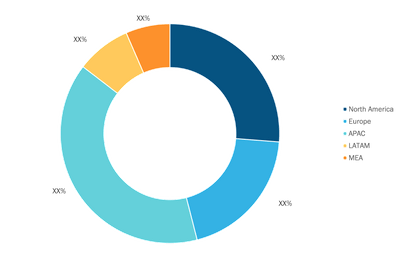Surging Demand for Automotive Telematics to Drive Automotive Memory Market during 2022–2028
According to our latest market study on "Automotive Memory Market Forecast to 2028 – COVID-19 Impact and Global Analysis – by Product, Vehicle Type and, Application," the market is expected to grow from US$ 2,937.7 million in 2021 to US$ 14,652.8 million by 2028; it is anticipated to grow at a CAGR of 24.0% from 2022 to 2028.
Surging demand for automotive telematics is driving the internet of things (IoT) expansion, which is projected to drive increased demand for automotive memory. New automobiles now come with cutting-edge technologies such as advanced driver assistance systems (ADAS) and predictive and self-intelligence systems. All of these functions necessitate the use of an automotive microcontroller. Memory is built into automotive microcontrollers for data storage and transport, and the growing demand for such features contributes to an increase in the need for automotive memory. These factors collectively drive the growth of the automotive memory market size globally.
The APAC automotive memory market is segmented into Australia, China, India, Japan, and South Korea. The region's economy is performing well due to numerous technological and infrastructural developments. The Asia Pacific region is expected to grow rapidly during the forecast period. The rising government initiatives for smart cities and smart traffic management systems are largely responsible for the region's tremendous growth. Furthermore, factors such as steadily increasing economies, expanding internet access and high-speed networks, and technical advancements in the automotive sector are all boosting the the Asia Pacific automotive memory market growth. The region's need for self-driving cars has prompted OEMs to deploy advanced telematics technology and services, projected to boost the automotive memory market size.
The global automotive memory market value chain comprises the following stakeholders- R&D, manufacturing, marketing & sales, and end-users. The company's R&D efforts primarily focus on developing industry-leading memory and storage solutions that enable performance and cost structure improvements for automotive memory products. A variety of suppliers provide materials, parts, and supplies to companies. Players may acquire such products from sole-source suppliers in some situations. The availability of resources that satisfy demanding requirements and using third parties to offer components and services are essential to the supply chain and operations. Manufacturing semiconductor products is a complicated process that includes many precise phases such as wafer fabrication, assembly, and testing. The successful deployment of sophisticated semiconductor manufacturing techniques across many facilities is required for efficient semiconductor product production. Companies mainly market and sell their products through direct sales channels, including websites, broad sales and applications teams, and distributors. For instance, NXP Semiconductors N.V. sells its products and solutions to OEMs, ODMs, contract manufacturers, and distributors worldwide. End-users of automotive memory include OEMs and automobile manufacturers.
The automotive memory market is segmented on the basis of product, vehicle type, and application. Based on product, the market is segmented into DRAM, NAND, SRAM, and others. Low Density SLC NAND Flash Memory Type, the type of NAND considered, is further segmented into 8Gbit, 4Gbit, 2Gbit, and Others. On the basis of vehicle type, the automotive memory market is segmented into passenger and commercial vehicles. By application, the automotive memory market is segmented into infotainment & activity, ADAS, and others.
Automotive Memory Market Share — by Geography, 2021

Automotive Memory Market Report | Growth & Size Analysis by 2031
Download Free Sample
Automotive Memory Market Size and Forecast (2021 - 2031), Global and Regional Share, Trend, and Growth Opportunity Analysis Report Coverage: By Product (DRAM, NAND, SRAM, NOR, and Others), Vehicle Type (Passenger Vehicle and Commercial Vehicle), Application (Infotainment & Connectivity, ADAS, and others), and Geography
Automotive Memory Market Report | Growth & Size Analysis by 2031
Download Free SampleAutomotive Memory Market Size and Forecast (2021 - 2031), Global and Regional Share, Trend, and Growth Opportunity Analysis Report Coverage: By Product (DRAM, NAND, SRAM, NOR, and Others), Vehicle Type (Passenger Vehicle and Commercial Vehicle), Application (Infotainment & Connectivity, ADAS, and others), and Geography
Micron Technology, Inc.; Sk Hynix.; Samsung Electronics Co., Ltd.; Western Digital Technologies, Inc.; Infineon Technologies AG; Macronix International Co.; Integrated silicon Solution, Inc.; Renesas Corporation; Qualcomm Technologies, Inc.; MediaTek, Inc.; Toshiba Corporation; STMicroelectronics; Nanya Technology; Texas Instruments Inc. and Windbond Electronics Corp. are among the key automotive memory market players profiled during this study. In addition, several other important market players were studied and analyzed during this market study to get a holistic view of the global market and its ecosystem.
The pandemic has caused destruction to various industry players in terms of business and operational factors, including the worldwide automotive memory market growth. Countries worldwide were forced to execute a nationwide lockdown when the World Health Organization (WHO) labeled the new coronavirus a pandemic. As a result of the lower vehicle demand in 2020, the demand for automotive memory decreased dramatically. Automobile and components production sites have closed worldwide, consumer traffic in showrooms has plummeted, and governments in various regions have placed temporary trade restrictions, resulting in a major decline in automobile sales. Such factors strongly hampered the business of automotive memory market players. Further delays are expected according to vendors and logistic businesses, which might drive up the cost of sourcing components and shipping. While some companies have increased their sourcing to avoid further disruptions to the supply chain, manufacturers are concerned about the situation because they are already dealing with a severe shortage of components, including semiconductors, which has forced them to limit production despite the high demand for automobiles. Even after the COVID-19 pandemic, the connected car industry will continue to grow because of benefits like secure driving, remote control, auto fault diagnosis, and more advanced technological features.
Contact Us
Phone: +1-646-491-9876
Email Id: sales@theinsightpartners.com